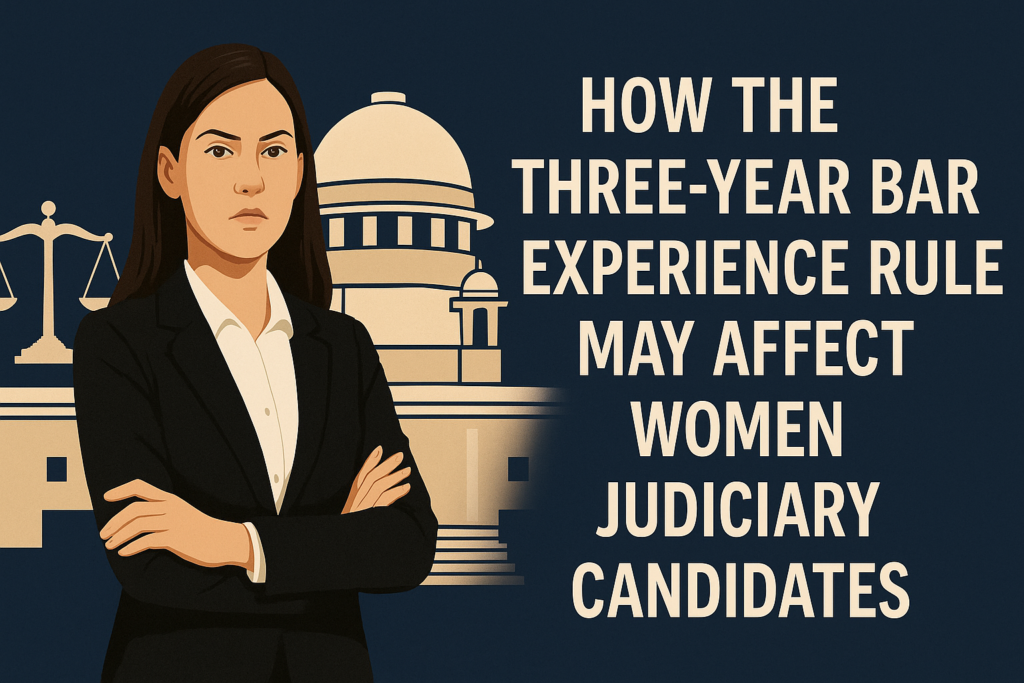
SU P R E M E C O U R T O F I N D I A
RECORD OF PROCEEDINGS
Writ Petition(s)(Civil) No(s). 1022/1989
ALL INDIA JUDGES ASSOCIATION & ORS. (Petitioner(s))
VERSUS
UNION OF INDIA & ORS. (Respondent(s))
Introduction
On May 20, 2025, the hon’ble Supreme Court of India, delivered in its landmark judgement in All India Judges Assn. v. Union of India,[1] reinstated mandatory requirement of a minimum three years of legal practice for aspirants seeking an appointment as a Civil Judge (Junior Division). The judgement, reserved by a three-judge bench on January 28, comes in response to the growing concerns from High courts with respect to lack of courtroom experience and practical exposure among the newly recruited judicial officers. There’s a mandate of accumulating at least three years of legal practice that shall be counted from the date of provisional enrolment with State Bar Council, and not from the date of clearing the All India Bar Examination (AIBE).
The court specified that the required legal experience must be formally certified and endorsed by an advocate with a minimum of ten years of professional standing. It is important to note that the court has clarified that experience as a judicial clerk will also be considered valid for meeting the criteria. In addition to that, all new judicial appointees will be required at least an year-long training program before they begin presiding over cases. The decision requires all State governments to update their service rules to reflect this new eligibility requirement, even though it will only be applied prospectively and won’t impact current hiring practices. A certified endorsement of experience from a practicing advocate with at least 10 years of Bar experience is another requirement for candidates.
As we all know, the Judiciary has long stood as the symbol of fairness, equality and justice. Yet, the path to becoming a judge in India, is governed by eligibility criteria that often reflects systematic biases – both visible and invisible. It has sparked a crucial debate and raises several concerns for both, the future of aspiring legal professionals as well as the broader justice delivery system. While it must be understood that the decision aims to enhance the quality, preparedness and competence of judicial officers, it inadvertently erects new barriers, especially for fresh candidates and women, who often tend to face systematic challenges in accessing as well as sustaining litigation practice.[2] This development necessitates a more deeper examination whether experience-based eligibility actually advances the objectives of judicial excellence or if it only serves to perpetuate already-existing disparities in the legal profession.
Also read: A complete discussion on “3-year bar experience rule” set up by The Supreme Court of India
History of the Longstanding Debate
The judiciary has historically served as both protector of core constitutional principles as well as the guardian of the ultimate symbol of justice, in a democratic society like India. Hence, it is important and seems necessary to note that the question of whether prior legal experience should be required for the appointment to the lower judiciary has been the subject of extensive deliberation not just in the recent months, but for decades. Over the course of these years, various statutory enactments and judicial pronouncements have sought to enhance maximum coherence and effectiveness of the judiciary by balancing and modulating the launching of judges at the lower court.
The 116th Law commission took a critical stance against the requirement, arguing that a limited duration of the legal practice was inadequate to impart the depth of training needed for judicial competence.[3] On the basis of this reasoning, the 117th Report went further, stating that it was unsustainable to assume that such brief bar experience alone could equip a person to serve effectively as a judge. The decision to remove the necessary three-year practice requirement was made because it was thought that many practitioners had lost interest in a career as a judge after getting some litigation experience. After this, the Shetty Commission saw a drop in the quality of applicants for the Judicial Services Examination, which led to a re-examination of the current methodology. As a response to the rising concerns, the Supreme Court recommended replacing the practice requirement with at least one to two years of practice and experience as a part of structures training for newly appointed judicial officers and directed the State Government to amend the recruitment rules accordingly. This disputable matter in question reached before the Supreme Court in the AJIA case[4] in 1993 where the court gave the judgement that state judiciaries should appoint only those specific advocates who had acquired a minimum of at least three years of courtroom exposure and continuous practice. However, the Supreme Court abolished the practice requirement in 2002 after supporting the Shetty Commission’s suggestion to do so, citing the fact that it discourages exceptional individuals from entering the judiciary. In this instance, the Court observed that quite a few law graduates may be unable to find a career in judicial service to be enticing enough after three years of practicing law.
The Court has now adopted a different stance, noting that it is difficult to select recent law graduates as judges because of their inexperience.
Exclusion to Inclusion – How this Rule May Affect Women Candidates
From a system that was gradually becoming more inclusive to one that risks reinforcing exclusion, especially for women- the three-year mandatory legal practice rule marks a crucial shift. Though the direct recruitment model over the past two decades, had opened many doors for meritorious women in law graduates to join the judiciary early in their career paths, offering them a stable as well as a respectable alternative to the often unpredictable and male-dominated world of litigation. Now, with the current reimposition of the Bar experience requirement, the path to the bench becomes all the more difficult. The impact of this revised rule is anticipated to disproportionally affect women, placing greater hurdles in their path to entering judiciary. While it is understandable that the mandate applies at everyone uniformly, its real life impact is far from equal. It sidelines a significant number of capable women who might otherwise have pursued a judicial career through direct recruitment. It not only narrows down the pipeline of women entering the judiciary but also risks reinforcing the gender imbalance in a system that already struggles with representation at the bench.
According to National Family Health Survey (NFHS) data from 2019-21, the typical median age at which first marriage for women in India stands at 19.2 years among women age 20-49, on the other hand for men, it’s 24.9 years.[5] When this demographic reality is in hand contrasted with the typical trajectory of career entry in the legal education, an evident and a stark disparity emerges.
Most students completing a five-year integrated law degree graduate around the age of 22. Candidates can only realistically sit for the judicial service tests at the age of 25 or later due to the restored requirement of three years of legal practice prior to qualifying. This timeline puts women at a clear disadvantage, particularly those from traditional, rural, or socially conservative families, even though it may be in line with the average age of marriage for men.[6] Many of them experience growing pressure from their families and society to get married and take on household duties during the post-graduation phase.[7]
Therefore, the delayed entry into the court may therefore be more than just a professional annoyance; rather, it may be a deciding obstacle that drives many gifted and competent women to abandon their goals entirely. Thus, what on paper seems to be a neutral requirement has profoundly gendered effects in practice, which could undo the modest but significant progress made to increase the number of women on the bench.
Rethinking gender realities of Litigation
The assumption that the three-year rule is neutral and is universally attainable ignores the deeply ingrained gender discrimination and unequal treatment that continue to imbue the legal profession. For many females, particularly the marginalised or conservative backgrounds, entering the field of litigation is not just another career choice for them but a navigation through a landscape riddles with structural barriers as well as social prejudices. It is a well- known fact that the profession’s unstructured and demanding schedule, which is often characterised by long hours, unpredictable case timelines, inordinately have an impact on women, specifically in the absence of robust maternity benefits or family-friendly work policies. Certain important facers of litigation including mentoring and guidance are often restricted to male dominated professional circles, which tend to undermine women’s access to possibilities for career defining experiences and informal guidance. These obstacles are much more pronounced for those lacking institutional support or socio-economic status making litigation not only inhospitable but also inaccessible for a large section of women.
The reality of “brief-less” practice in the early years exacerbates these difficulties. Junior advocates may find themselves working in secretarial or peripheral roles with little exposure to real courtroom advocacy, especially if they lack strong professional or familial ties. Instead of providing useful preparation in such a setting, the required three-year practice period runs the risk of acting as a gatekeeping device, weeding out talented and dedicated women before they ever have the opportunity to participate. In the end, policies must take into consideration the difficult path women must take to get to the bench if the judiciary is to be genuinely representative, inclusive, and sensitive to societal realities. Without addressing systemic disparities, a rule that presumes equality of access runs the risk of escalating the very imbalance it is intended to solve.[8]
Other Reasons to Ponder
- Undue Delay in Career Progression
Many law graduates are often eager to contribute to the legal system directly after completing their academic training. A three-year wait may imply missing out on that drive as well as the fresh perspectives they could offer the judiciary. While there’s no attempt limit, age is a real filter as it may restrict prolonged efforts.
- Need for Judicial Reform
In an era that is marked by rapid social, technological and legal revolution, the judiciary must reflect and respond to the challenges of the changing society. By creating unnecessary barriers to their entry, the system may tend to lose the opportunity to modernize itself through the contributions of individuals who are in touch with today’s legal landscape.
- Restricted Access to Opportunities
The socioeconomic realities that many candidates face are ignored when it is assumed that all graduates can afford to practise law for three more years. Long-term litigation careers might be unsustainable due to a combination of financial limitations, family obligations, and cultural expectations, especially for women and students from disadvantaged or rural areas. This regulation runs the risk of disqualifying a large number of gifted applicants, so reducing the variety and inclusivity of the pool of potential judges.
- Reduced preparation window
This rule significantly alters the preparation timeline for aspiring judges. Earlier they had the leverage to start preparing for judicial service examination immediately after completing LLB, often enrolling themselves in coaching programs while their academic knowledge was still fresh. However, now with a mandatory three-year stint in active legal practice, this transition is no longer possible. Instead, aspirants will now be forced to either prepare alongside a demanding litigation career often marked by long working hours and minimal income; or postpone their preparation until after fulfilling the requirement. As can be seen, both these options present unprecedented challenges. Balancing rigorous exam preparation with courtroom responsibilities may compromise both the learning practice as well as job performance.
Conclusion and Suggestions – A Fairer Path to Gavel
Judicial reform should aim not only to raise the quality, but also ensure that the path to the bench remains inclusive as well as accessible. While well intentioned, the reinstatement of the three-year rule risks excluding large sections of aspirants- particularly women and the first generation lawyers, who tend to often find the litigation pathway unsustainable and inaccessible. Structured judicial internships, supervised by judges or senior advocates, could provide the necessary courtroom exposure without even compelling the candidates into full-time litigation. These alternatives may help the law graduates in more ways than one and help them acquire practical skills while navigating safer and structured environment.
Simultaneously, To make litigation a viable and respectable arena for everyone, it must be transformed. To make courts safer for women, it is imperative to put strong anti-harassment procedures into place, require gender-sensitive training, and set up independent grievance redressal procedures. Financial obstacles must also be removed; junior attorneys’ stipends or honoraria could greatly ease their early practice years, especially for those without family or institutional backing.
In the end, policies must take into consideration the difficult path women must take to get to the bench if the judiciary is to be genuinely representative, inclusive, and sensitive to societal realities. Without addressing systemic disparities, a rule that presumes equality of access runs the risk of escalating the very imbalance it is intended to solve. Finally, it must be understood that legal education reform is vital. Only by policies based on empathy, reality, and justice can a competent and representative judiciary be established. The emphasis needs to change from just increasing entrance requirements to actually developing future judges. Because the objective is to make sure that no worthy voice is silenced before it has a chance, not merely to improve who gets to sit on the bench. In the end, policies must take into consideration the difficult path women must take to get to the bench if the judiciary is to be genuinely representative, inclusive, and sensitive to societal realities. Without addressing systemic disparities, a rule that presumes equality of access runs the risk of escalating the very imbalance it is intended to solve. At the end, it shouldn’t just be about who actually makes it to the bench, but also about the ones who get left behind by the very reform.
[1] All India Judges Association vs Union Of India on 4 March, 2025, https://indiankanoon.org/doc/66299482/ (last visited Jun. 1, 2025).
[2] Shailesh Kumar Rajora, How the Three-Year Bar Experience Rule May Affect Women Judiciary Candidates, Bar and Bench – Indian Legal news (May 27, 2025), https://www.barandbench.com/columns/women-and-the-three-year-rule.
[3] Faizan Mustafa & Shrey Shalin, The 3-Year Rule: A Setback to Judiciary Aspirants, The Hindu, May 21, 2025, https://www.thehindu.com/news/national/3-year-rule-a-setback-to-judiciary-aspirants/article69597321.ece.
[4] All India Judges Association vs Union Of India on 4 March, 2025, supra note 1.
[5] FR375.Pdf, https://dhsprogram.com/pubs/pdf/FR375/FR375.pdf (last visited May 29, 2025).
[6] Rajora, supra note 2.
[7] Law School Policy Review, Benchmarks For The Bench: Revisiting The Three-Year Practice Rule For Judicial Exams?, Law School Policy Review (May 8, 2025), https://lawschoolpolicyreview.com/2025/05/08/benchmarks-for-the-bench-revisiting-the-three-year-practice-rule-for-judicial-exams/.
[8] Ratna Singh, Supreme Court Reinstates 3-Year Bar Experience for Civil Judges: What It Means for Judiciary Aspirants, Bar and Bench – Indian Legal news (May 25, 2025), https://www.barandbench.com/columns/supreme-court-reinstates-3-year-bar-experience-for-civil-judges-what-it-means-for-judiciary-aspirants.







